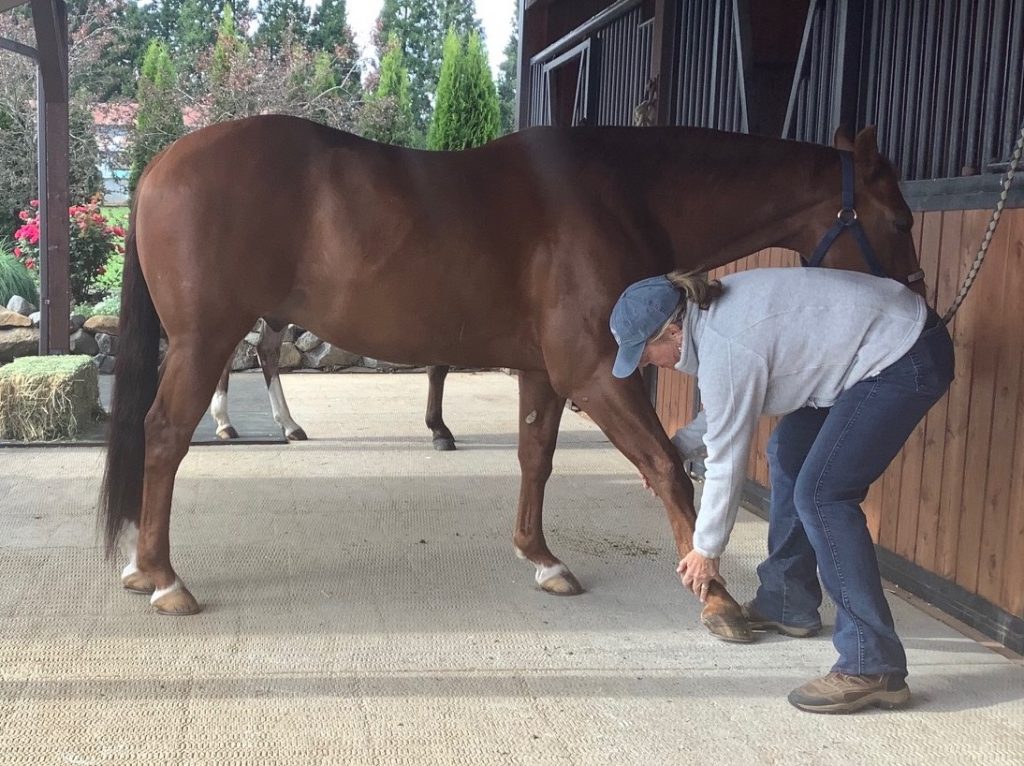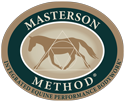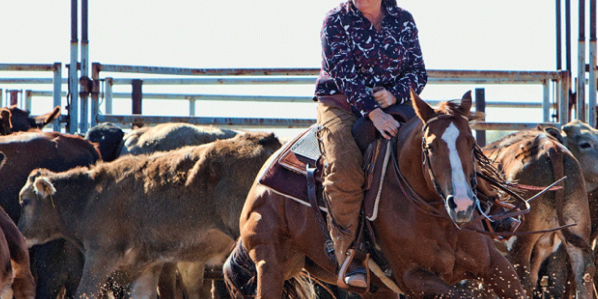By Lisa Haldane, MMCP and owner of Avalon Performance Horse and Rider Support
In Part One of this series, I talked about the daily routine for cutting horses in a training and show environment. In Part Two I talked about the Masterson Method techniques that are most useful in supporting the mature cutting show horse. In this last segment I want to discuss supporting the younger cutting horse in training from two to four years old.
As you can imagine, this is the most challenging time in these horse’s lives and there is much we can do to make this period more comfortable for them if the Masterson Method can be integrated into their lives on a regular basis. A practitioner who has a good relationship with a responsive trainer can provide valuable feedback on particular areas of discomfort.
Following are my observations on these years and what Masterson Method work might be helpful at each stage:
Two-Year-Olds: During this time their bodies are developing strength and balance to carry the weight of the rider. Very early on they are introduced to the concepts of traveling straight, stopping, backing and turning with the use of a mechanical flag or slow-moving cattle to generate interest and a target for the horse to follow.
Most forward work is done at the trot. Sessions are kept very short, initially 15-20 minutes, gradually increasing as the colt gains strength and condition. Trainers will also be exposing these young horses to the countryside and cattle if they have access so that they are mentally prepared for a variety of experiences. By the end of this year they will be very strong, will have learned to stand quiet when tied for periods of time, and will be able to travel quite well in the trailer to new environments. They will have had a lot of exposure to other horses and cattle in the training environment and will have learned to read the movements of a cow very well.
Physically the biggest challenges in the two-year-old year are the development of physical strength and coordination in what is the horse equivalent of army basic training. Think of the young person who is not physically very active entering into army boot camp and how they have changed physically and mentally when they emerge from that first intensive period. There was likely a lot of discomfort along the way but that isn’t necessarily a bad thing if managed properly; it’s a time to build strength.
Masterson Method for Two-Year-Olds:
These horses are uniquely intelligent, high energy, and have a very short attention span at two. They may have problems with ulcers from their new regimen and they will have areas of physical discomfort that will pass or change as they gain strength and coordination.
Most of my time with two-year-olds is spent getting them to settle and accept our light touch. Once we begin to bring their attention to areas that might be uncomfortable it’s not uncommon to get extreme fidgeting, pawing with the front feet, and sometimes biting and kicking out. I often need to tie them loosely to keep them in the area and in the initial sessions it can take 30 minutes or so to get through their expression of anxiety before they start to relax. I have to find areas of their body to touch that aren’t too challenging for them. I spend short amounts of time in different areas until I find the location where they will tolerate my touch and settle. The most neutral place is often the lumbar area where I go to rest my hands and let their back soften. If they will tolerate it, I do the bladder meridian technique. A typical session might last about 45 minutes and go as follows:
• Front legs down and forward/back. I make great use of loosening the fetlock and feeling the fascia loosen up into the forelimb and shoulder. I also don’t hold the foot up too long, letting it down to the ground softly but as soon as possible to avoid the fight over the foot.
• Lateral cervical flexion lightly two or three times/side
• Bladder meridian when the horse has started to settle
• Tongue release
• Hands resting on the lumbar in between techniques to encourage the back to soften and hips to drop
• Lateral rocking of the ribcage
• Sternum lift
• Hind legs down and forward/back with softness and no fight in holding the foot (they often will try to kick sideways)
• Diagonal and Dorsal Arches
Stifles and groins are likely going to be uncomfortable and sources of kicking out. I only work on these when there are 2 or more days where the horse isn’t going to be asked to stop and turn because loosening these structures makes it harder for the horse to maintain balance until it has developed sufficient strength.
Three-Year-Olds: The three-year-old year brings more intensive focus on cattle work with more self-discipline and accuracy developed in the horse with respect to the parameters of correctly working cattle. This sport requires the horse to think and act on its own while maintaining self-discipline, focus, and listening to the aids of the rider. During the two-year-old year the trainer was using a lot of hand and leg to help the horse understand how it should move its body and how to rate itself with respect to the movement of the cow.
During the three-year-old year the use of the hands is lessened during the training session so the horse is given more and more responsibility to travel across the arena with the cow in good position to control its movement while maintaining the proper distance from the cow, working parallel to and in time with the actions of the cow. The cattle work will build to more challenging situations with quicker stops and turns and intermittent rapid travel across the pen. Towards the end of the three-year-old year the horses will be going out to their first shows if they can reliably work accurately with no rein assistance from the rider while working a cow.
Physically the three-year-olds are strong and will have begun to set into their structure the tone that is necessary to meet the demands of their work. Shoulders, hocks, stifles, groin, hamstrings and back will all be working hard and may become fatigued and sore. The training sessions are longer and more exacting. There can be build-up of lactic acid in the muscles if the program doesn’t allow for long enough periods of cool down after the training sessions. Caps on teeth are also an issue that needs to be monitored during the three-year-old year as they can cause great discomfort and resistance to training.
Masterson Method for Three-Year-Olds:
If I have been working on them as two-year-olds, they now know that their bodywork session is a pleasant time and will be a lot more peaceful. They’ve learned how to relax their own hindquarters and will release through the forelimbs quite easily. I’m careful to work on them when they will have at least a couple of days off to integrate what I’ve done and rebuild their muscular integrity.
I would do all the same techniques as I did on two-year-olds, adding in withers releases, sternum lift, under tail points, head up/down. I would not do under scapula releases on any young cutting horse.
Four-Year-Olds: Trainers report that the four-year-old year can be one of the most difficult. The horse has largely been trained and shown some by this time. Now the focus is on the horse taking even more responsibility for controlling the cow correctly at even greater intermittent speeds. Physically, changes in the teeth are still an issue that can cause resistance in training and there may be some physical fatigue and soreness that has accumulated if the horse is not seen regularly by the vet, resulting in more training challenges.
Masterson Method for Four-Year-Olds:
By the four-year-old year the physical patterns have largely been set into the horse. It is extremely strong and has developed ways to compensate for physical asymmetries in its body. Hopefully through the bodyworker’s observations and trainer awareness these have been minimized to the extent possible. I would still be working on this horse only lightly during the most intensive part of its week with more complete sessions being reserved for times when there are days of rest to allow for physical reintegration of the horse’s muscular integrity. Ideally I would have taught the people who normally groom and saddle the horse how to:

• Do simple releases of the front and hind legs (down and forward/back and fetlock loosening) when they are cleaning the feet (this softens the fascia all the way up into the trunk)
• Do some light lateral cervical flexion when they are grooming • Do some light softening along the top of the back with Masterson Light to the Core techniques before saddling
• Do some light poll releases when they are bridling
This would be a way to daily integrate softness and release into the horse’s program so that the regular full bodywork sessions result in smaller needed increments of change and release. What is very gratifying is how easily these young horses release tension and appreciate the softening that is allowed. This is also an excellent time when the bodyworker can help identify issues that are occurring in the horse that might not be so easily recognized. Our hands can tell us a lot about the health of the horse and if we have a good relationship with our trainer or client we can help keep that horse on a positive path. This requires that we work on the horse often enough to recognize what is normal for that horse, what is new, and what might be normal for that horse but not necessarily healthy.
I’ll end this conversation with a recent example of a three-year-old horse that was described as being stiff in the body. It was understood that the mother was that way as well and felt that it was just something that couldn’t be helped. Genetic traits are definitely there, but they need not always predict an outcome. In the case of this young horse extreme muscular tension would return within just a day or so of my working on him. Testing revealed that the horse’s vitamin E level was at the bottom of the range. Vitamin E and Selenium are vitally important for muscular and nervous system health and, once supplemented, there was great improvement in this young horse. It may be that this particular bloodline of horses needed extra care in supplement management and it would have been interesting to do some genetic testing to verify if there were certain conditions present. This would not have been found unless someone with sensitive hands had brought up the issue.
This is the wrap up of this series. If you have any questions or want to discuss this work further, please feel free to contact me at .
Learn more about The Masterson Method® by ordering a copy of the Beyond Horse Massage Book.
Get hands-on training at a Beyond Horse Massage Weekend Seminar near you.













